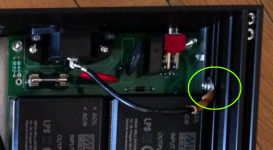Very nice! Which chassis is that? Looks like a Modushop one, but which model?
You might be able to tidy up the supply harness with shorter wires, but what you have actually looks quite tidy already.
Did you sand off the black anodization under the grounding lug? If not, then I recommend doing so for a better connection.
Tom
You might be able to tidy up the supply harness with shorter wires, but what you have actually looks quite tidy already.
Did you sand off the black anodization under the grounding lug? If not, then I recommend doing so for a better connection.
Tom
Attachments
Thanks for your feedback, Tom! And thanks again for all your help and patience with all the questions I had!
It's a modushop galaxy chassis with the "no visible screws" option. I also turned the side panels inside out for a cleaner look.
I didn't have any sand paper when i finished it so I just scratched the surface with a screw driver to take off some anodization. I will sand it in the next couple of days and maybe take the wire to the back panel and make it even shorter.
It's a modushop galaxy chassis with the "no visible screws" option. I also turned the side panels inside out for a cleaner look.
I didn't have any sand paper when i finished it so I just scratched the surface with a screw driver to take off some anodization. I will sand it in the next couple of days and maybe take the wire to the back panel and make it even shorter.
Good idea, in the meantime check you have continuity to the chassis and most importantly the pot shaft and knob. Looks good
keeps the amp much cooler than i thought it would.
That's a good thing!
My design philosophy is that the amp needs to be able to deliver the full rated output power continuously without hurting itself or the user. I'm willing to reduce this requirement to: The amp needs to be able to continuously deliver a music signal at levels just below clipping. I think that's good engineering. That's also why your amp is running cool.
Many DIYers (and some commercial vendors as well) use the fact that few users ever drive the amp to clipping to justify saving a few bucks on the heat sink. They end up with an amp that'll work well under normal listening conditions but will sound harsh or even shut down if they really crank it.
Each to their own... 🙂 My choice is to set you up for success. You now have an amp that'll work well for years to come. Congratulations!
Tom
Mixi,i bought it directly from fischer electronic in germany: Fischer
keeps the amp much cooler than i thought it would.
did you find a download of the heatsink simulation software?
Shame.
I found a link for downloadable software some while ago, but can't find it now.
Another Member was asking about device location details, but I was unable to refer him to the manufacturers' recommendations.
I found a link for downloadable software some while ago, but can't find it now.
Another Member was asking about device location details, but I was unable to refer him to the manufacturers' recommendations.
Heat Sink Peltier Coolers Heat Spreader Calculator | Novel Concepts
This calculator will not work for a vertically oriented passive heatsink. Nor will it show the temperature profile over that vertical surface/interface.
This calculator will not work for a vertically oriented passive heatsink. Nor will it show the temperature profile over that vertical surface/interface.
can anyone tell me which class of amp (AB ?) the lm3886dr is? i hope this isn't a super silly question ....
This is a trick question.. depends on the voltage you give it... if you give it enough volt, it becomes class A.
The LM3886DR is Class AB. In order to change it to Class A you would have to increase its bias current dramatically. This is not possible without redesigning the LM3886 IC.
Tom
Tom
Thankfully they get it right in the parametrics. Bare in mind it could have been made and that could have been written almost anywhere in the world
- Home
- Amplifiers
- Chip Amps
- Neurochrome LM3886DR Build



